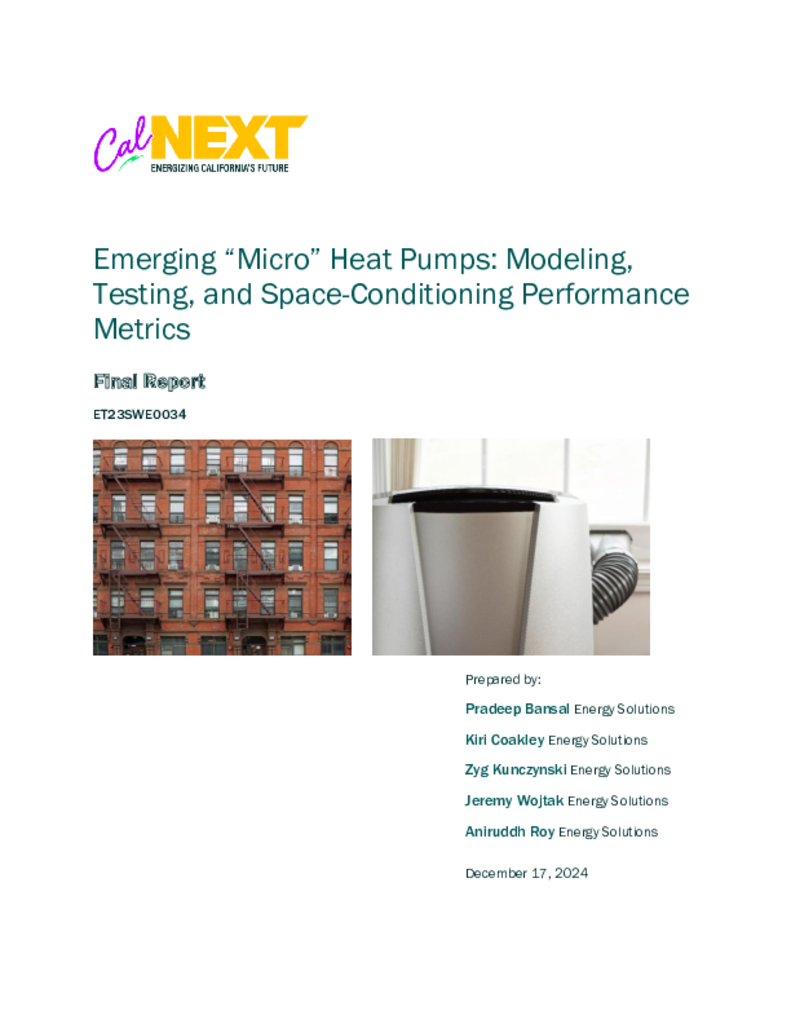ET23SWE0034 - Emerging “Micro” Heat Pumps: Modeling, Testing, and Space-Conditioning Performance Metrics
The State of California has an ambitious goal to install at least 6 million heat pumps by 2030. To address this need, several novel “micro” heat pumps are emerging in the consumer market that offer the ability to provide space heating and are powered by common household 120V electrical service without the need for a contractor or permit. These products include unique form factors (e.g., aesthetically attractive shapes, configurations, easy installation, etc.)and advanced performance features such as inverter-driven compressors and heating capabilities in cold climates.
“Micro” heat pumps have the potential to replace small gas-fired furnaces or inefficient electric-resistance space heaters commonly used in multifamily settings. This is possible by reducing or eliminating many cost barriers associated with the design, installation, and permitting required for traditional heat pump technologies. These products could eliminate tenant disruptions or displacement and could potentially empower tenants with a solution to reduce their energy bills. While several studies are beginning to examine these units in the field, to date the Project Team is not aware of any efforts to bring research focused on the gap in the heating test performance of these units.
The goal of this project will be to work collaboratively with key stakeholders to test or model the cooling and heating performance associated with “micro” heat pumps. The Project Team will work with manufacturers, regional efficiency research partners, and relevant organizations working on “micro” heat pumps emerging in the consumer market. Following these conversations with key stakeholders, the Project Team will test several heat pumps in a National Recognized Testing Laboratory (NRTL), to obtain performance data and share the test results with key stakeholders. The aim of this work is to lay the technical groundwork that will allow utilities to provide incentives for this rapidly emerging market. Testing efforts at NRTLs are contingent upon contractual approval to engage in testing efforts with NRTLs.
In pursuit of California’s ambitious goal of installing six million heat pumps by 2030, emerging technologies such as micro heat pumps (MHPs) available in multiple form factors can serve as additional options for heating and cooling needs in certain single family and multifamily buildings. MHPs in new form factors are entering the U.S. market that could potentially address critical barriers to the consumer such as high costs to electrify, the skilled labor challenges, limited electrical capacity within existing electric panels, or the split-incentive challenge. MHPs are self-contained, up to 120V, and have variable-speed compressors that can provide space cooling and heating in ambient temperatures down to 5º Fahrenheit (F) or lower for spaces up to 1,000 square feet. The goal of this project was to work collaboratively with key stakeholders to test and model the cooling and heating performance associated with MHP. To do this, the CalNEXT project team networked with manufacturers, trade associations, state agencies, utility representatives, energy efficiency advocates, and regulatory bodies. The project team identified MHP units with various form factors such as saddle type, through-the-wall, portable heat pump and window systems. In tandem with this project, the U.S. Environmental Protection Agency (EPA) finalized its Test Method to determine RAC heating mode performance in July 2024, and defined a new heating performance metric for room heat pumps with various compressor types. The project team formulated its test plan around this ENERGY STAR Final Test method, and performed energy modeling to estimate performance of MHPs in some California climate zones using tested data. The energy modeling approach replicated the analysis performed by DOE and EPA on fractional heating bin hours in the Final Test Method while laboratory testing investigated EPA’s Final Test Method on room heat pumps with different MHP form factors. Although this Final Report presents laboratory testing results on heating and cooling performance of certain MHPs, further investigative testing opportunities exist for these products via CalNEXT or other interested parties.

